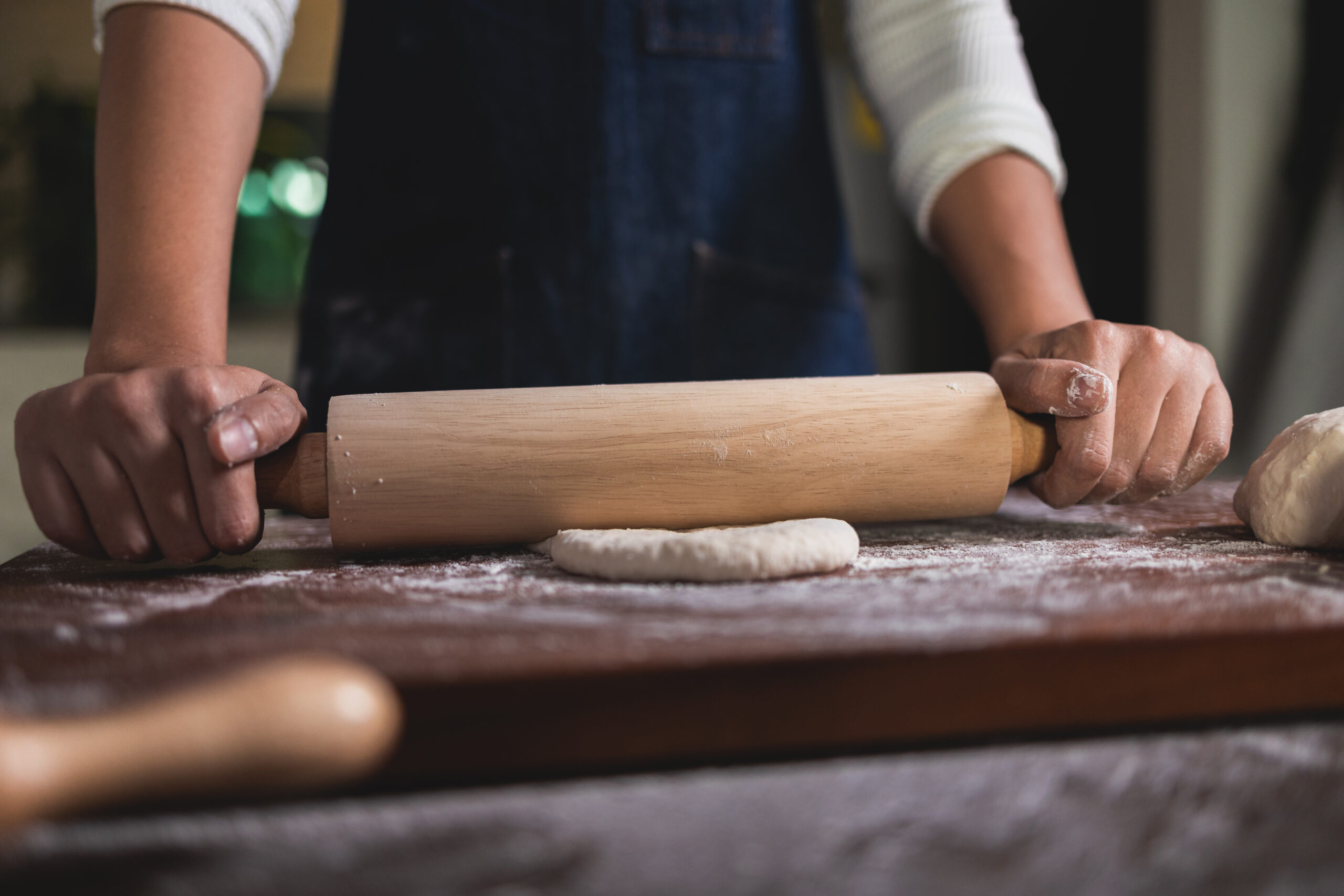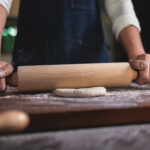If you’re serious about baking, a good rolling pin can make a big difference. It helps you roll out dough evenly, with little effort. There are different styles, materials, and sizes of rolling pins. Here’s a complete breakdown.
Why Your Rolling Pin Matters
A rolling pin is a key part of many baking tasks. If your pin is too heavy, too light, or not comfortable to hold, you’ll have trouble rolling dough evenly. Uneven dough leads to uneven baking, which will then affect the taste of your food.
A good rolling pin should feel balanced, fit your hands well, and works with the type of dough you use most often.
Types of Rolling Pins
There are four main types of rolling pins:
French Rolling Pin
A French rolling pin is a simple, straight rolling pin without handles. It usually tapers at both ends, which gives you better control when rolling out dough. It’s made of a single piece of wood.
It’s great for rolling out pie crusts, cookies, pizza dough—pretty much anything. Most bakers prefer it because it’s easier to clean and maneuver.
- Pros: Great for control and precision. Easier to feel the dough while rolling.
- Best for: Pastries and delicate doughs like pie crusts.
- Downside: Takes more skill to use evenly.
Straight (Rod) French Rolling Pin
A straight (rod) French rolling pin is a long, smooth cylinder with no handles and no tapering at the ends. It’s just one solid, even-width piece of wood from end to end.
This type gives you full control and an even pressure when rolling out dough. It’s great for things like sugar cookies or puff pastry.
It also gives you more surface area than a tapered pin, which means fewer passes to roll out your dough. And because there are no moving parts, it’s super easy to clean and store.
- Pros: Easy to clean and store. Good control over pressure.
- Best for: Cookies, tarts, and pizza dough.
- Downside: May be harder for beginners to apply even pressure.
Rolling Pin with Handles (American Style)
This is what most people picture when they think of a rolling pin. It has a thick center barrel that rolls, and two handles on the sides that stay still while you roll.
The barrel usually spins on a rod, which makes it easy to roll dough back and forth without much effort. It’s especially good for beginners or if you’re working with stiff dough, like cookie or bread dough. This type is heavier than a French rolling pin.
- Pros: Easy to grip. Better for people with less wrist strength.
- Best for: Bread dough, cookie dough, and large batches.
- Downside: Harder to clean. You may not feel the dough as well.
Textured or Embossed Rolling Pins
These pins come with patterns carved or raised on the surface like flowers, snowflakes, or geometric designs. When you roll it over dough, it presses those patterns right into it.
These are mostly used for decorating cookies, pie crusts, or fondant. They don’t replace your regular rolling pin. You still need to roll your dough flat first. Then you go over it with the textured pin to add the design.
- Pros: Used for decorating dough, especially cookies and fondant.
- Best for: Adding visual texture to baked goods.
- Downside: Not ideal for regular rolling tasks.
Tell me about Rolling Pin Materials now. Include only relevant and valuable content. Keep language simple, conversational. Don’t talk in circles. Talk to the point. Write as if you’re directly talking to the person.
Rolling Pin Materials
The material of your rolling pin also matters. It affects how the dough behaves and how easy it is to clean. Here are the most common types:
Wood
This is the most common. It gives you a good grip, doesn’t stick too much if you flour it, and feels solid. Great for all-purpose baking. Just don’t soak it in water—hand wash and dry it right away.
- Pros: Natural, non-stick with light flouring. Holds temperature well.
- Best for: All-purpose baking.
- Downside: Can stain or crack if not cared for. Hand wash only.
Marble
Heavy and naturally cool. It’s great for rolling buttery doughs like pie crusts because it keeps the dough from getting too warm. It can stick more, though, so you’ll need to flour your surface well. It’s also more fragile so be careful not to drop it.
- Pros: Great for pastry doughs that need to stay cold.
- Best for: Pie crusts, puff pastry, or croissant dough.
- Downside: Heavy and can break if dropped. Needs more storage space.
Stainless Steel
Smooth, heavy, and easy to clean. It doesn’t absorb odors or moisture, and some are even dishwasher safe. Like marble, it stays cool, which helps with pastry doughs. It can be slippery if your hands are wet.
- Pros: Non-porous. Can be chilled. Easy to clean.
- Best for: Sticky or buttery doughs.
- Downside: Can feel slippery. No natural grip like wood.
Silicone or Non-Stick Coated
Good for sticky doughs since they don’t grab onto the surface as much. But they’re usually lighter and don’t give as much control or pressure. More of a specialty choice.
- Pros: Easy to clean. Non-stick surface.
- Best for: Casual baking, fondant.
- Downside: Not as sturdy. Less control over pressure.
Plastic
Lightweight and easy to clean. Works fine for basic tasks, but it doesn’t give you the same control or pressure as wood or metal. Better for casual baking or kids.
- Pros: Easy to clean. Non-porous.
- Best for: Basic tasks.
- Downside: Less control over pressure.
What to Look For in a Rolling Pin
If you’re shopping for your first or next rolling pin, here are the most important things to consider:
- Weight: Heavier pins roll dough faster. A lighter pins give you more control. Go for a pin that falls in between.
- Length: Standard length is around 18 inches. If you bake regularly, go for a longer one.
- Balance: The pin should feel even and easy to roll without tipping to one side.
- Ease to Clean: Choose a design and material that’s easy to clean especially if you’re going to use it often.
Best Rolling Pin for Different Baking Tasks
To make it easier, here’s a quick breakdown of which rolling pin works best depending on what you’re baking:
Baking Task | Recommended Rolling Pin |
Pie crusts | French tapered (wood or marble) |
Cookies | Straight rod (wood or steel) |
Pizza dough | Handled pin (wood or steel) |
Bread dough | Handled pin (wood or steel) |
Puff pastry | Marble or chilled steel |
Decorative cookies | Embossed rolling pin (wood/plastic) |
Care and Maintenance Tips
To keep your rolling pin in good shape:
- Wood pins: Wipe clean with a damp cloth. Do not soak in water. Occasionally oil the wood with food-safe mineral oil.
- Marble pins: Wash with soap and water. Avoid using if chipped.
- Steel and plastic pins: Most are dishwasher-safe, but check the label.
Final Verdict
If you want a rolling pin that works for just about everything, go with a straight French wooden rolling pin. It’s simple, versatile, and gives you full control. If you make a lot of pie crusts or pastry, a marble pin might be worth adding to your tools.
Looking for something even easier to work with? Try the MisterChef Non-Stick Rolling Pin. It’s lightweight, easy to clean, and perfect for sticky doughs. Shop with us today.







